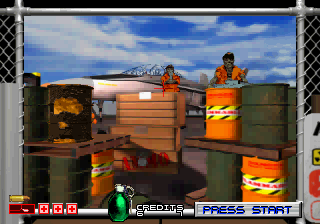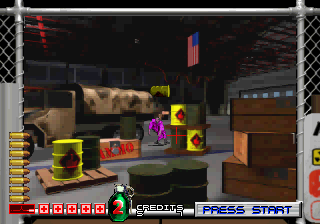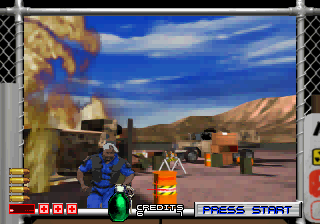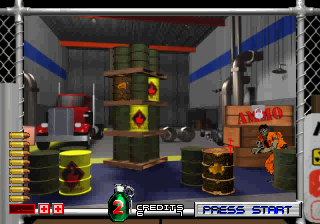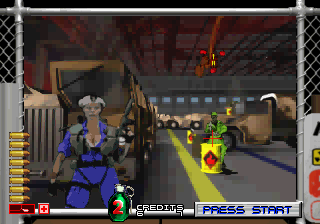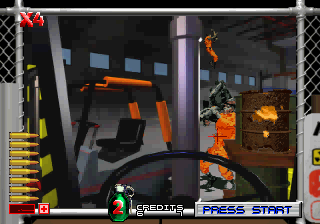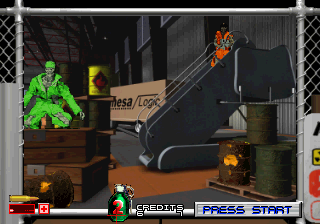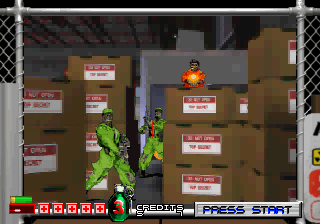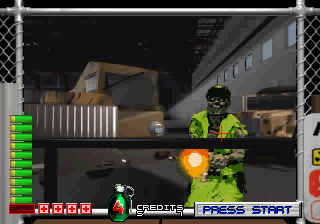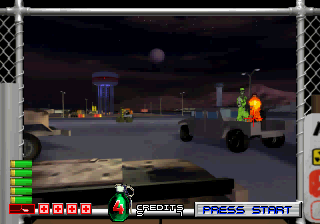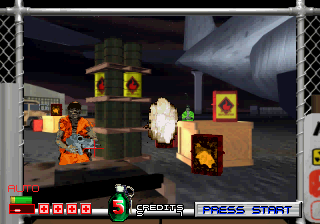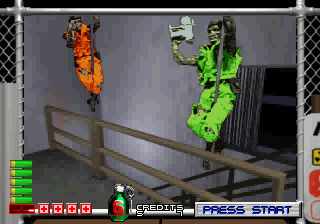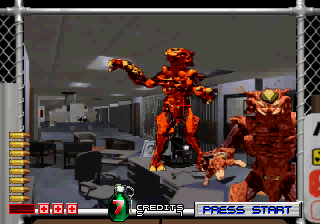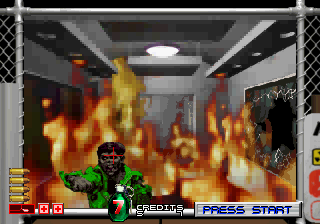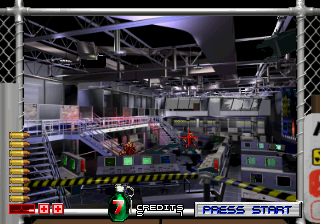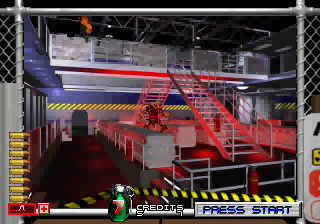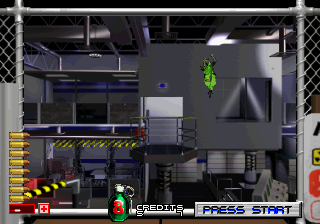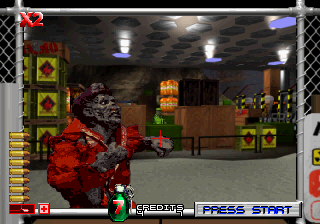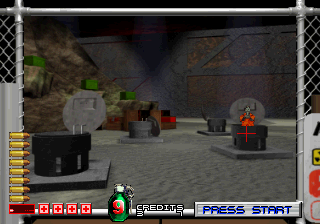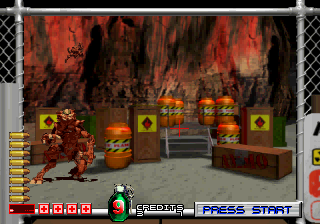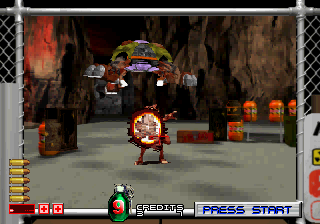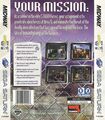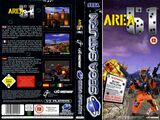Area 51
From Sega Retro
| Area 51 | |||||||||||||||||||||||||||||||||||||||||||||
|---|---|---|---|---|---|---|---|---|---|---|---|---|---|---|---|---|---|---|---|---|---|---|---|---|---|---|---|---|---|---|---|---|---|---|---|---|---|---|---|---|---|---|---|---|---|
| System(s): Sega Saturn | |||||||||||||||||||||||||||||||||||||||||||||
| Publisher: Midway Home Entertainment (US), GT Interactive Software (EU), SoftBank (JP) | |||||||||||||||||||||||||||||||||||||||||||||
| Developer: Mesa Logic, Tantalus Entertainment, Perfect Entertainment | |||||||||||||||||||||||||||||||||||||||||||||
| Distributor: Sega-Ozisoft (AU), Tec Toy (BR) | |||||||||||||||||||||||||||||||||||||||||||||
| Licensor: Atari Games | |||||||||||||||||||||||||||||||||||||||||||||
| Original system(s): Arcade boards | |||||||||||||||||||||||||||||||||||||||||||||
| Sound driver: SCSP (1 track) | |||||||||||||||||||||||||||||||||||||||||||||
| Peripherals supported: Virtua Gun | |||||||||||||||||||||||||||||||||||||||||||||
| Genre: Shooting[1][2] | |||||||||||||||||||||||||||||||||||||||||||||
| Number of players: 1-2 | |||||||||||||||||||||||||||||||||||||||||||||
| Official in-game languages: | |||||||||||||||||||||||||||||||||||||||||||||
| |||||||||||||||||||||||||||||||||||||||||||||
|
Area 51 (エリア51) is a 1995 arcade light-gun game developed by Mesa Logic and released by Atari Games. It was ported to the Sega Saturn in late 1996 by Tantalus Interactive and Perfect Entertainment and published by Midway Games, alongside versions for PlayStation and Windows PCs.
Contents
Story
Soldiers of the Strategic Tactical Advanced Alien Response (S.T.A.A.R.) military team have been deployed to Area 51 to repel an invading force of aliens, known as the Kronn, and alien-created zombies, who are taking over the facility. The team, led by Lieutenant Stephanie Grant and Sergeant Major Marcus Bradley, must infiltrate penetrate Area 51 and activate the nuclear self-destruct sequence.
Gameplay
Area 51 is an arcade, on-the-rails shooting game using light guns. The player must defeat genetically modified zombie soldiers and aliens without harming allied S.T.A.A.R. team members. The graphics are prerendered, using human actors (similar to Mortal Kombat) for soldiers, and full-motion video to simulate moving through the world. The game supports two-player cooperative play. The Arcade mode plays through all the stages of the original arcade game. There is also a Practice mode where players can practice shooting in a room with endlessly spawning enemies; players do not take any damage from enemies in Practice mode.
Players can use control pads or Virtua Guns. The game can also be played in "Cowboy Mode," where a single player uses two guns. Using a control pad, the D-Pad moves the crosshair, ![]() shoots, and
shoots, and ![]() reloads. Players start the game with semi-automatic pistols that hold 8 rounds each. Players are equipped with a limited supply of grenades, which are thrown with
reloads. Players start the game with semi-automatic pistols that hold 8 rounds each. Players are equipped with a limited supply of grenades, which are thrown with ![]() . Grenades are not aimed but attack every enemy on screen. Using a light gun, pulling the trigger while the gun is pointed at the screen shoots while pulling the trigger while aiming away from the screen reloads. Grenades are thrown by shooting the grenade icon on-screen.
. Grenades are not aimed but attack every enemy on screen. Using a light gun, pulling the trigger while the gun is pointed at the screen shoots while pulling the trigger while aiming away from the screen reloads. Grenades are thrown by shooting the grenade icon on-screen.
The game contains numerous hidden rooms. By shooting certain objects in the correct sequence, players can unlock shooting exercises, weapon stashes, and bonus items. Other backdoors allow players to warp ahead to later stages instead of following the game's otherwise linear path.
Players have a limited amount of lives, depicted by crosses on the bottom of the screen. When an enemy appears, players have a limited amount of time to shoot the enemy before taking damage from it and losing a life. Shooting a fellow S.T.A.A.R. member also costs a life. Players lose their weapon upgrades when they lose a life. The game ends if the player runs out of lives but can be continued if the player has a credit remaining.
There are five selectable difficulty levels (Novice, Easy, Medium, Hard, and Expert). Players can also set the starting number of lives and credits in the options prior to starting the game. Players can also enable looping, where the game starts over from the beginning when completed.
Objects
| Power Up | |
|---|---|
| When equipped with the starting pistol, shooting a Power Up equips players with either a shotgun or a machine gun. Shooting a Power Up when already holding a shotgun equips an automatic shotgun. Shotguns allow a greater field of error for targeting an enemy but only start with 5 rounds. Machine guns fire quickly and start with 10 rounds. Both the machine gun and automatic shotgun allow the player to keep the trigger pressed down to unleash rounds. | |
| Ammo Crate | |
| Ammo crates can be shot open and can contain extra grenades (each player can hold up to 9 grenades at a time) or extended ammo clips that allow the player to hold more rounds at once (10 for the shotguns or 19 for the machine gun). | |
| Barrel | |
| Explosive barrels can be shot to damage nearby enemies. |
Stages
| Stage 1 | |
|---|---|
| Stage 2 | |
| Stage 3 | |
| Stage 4 | |
| Stage 5 | |
| Stage 6 | |
| Stage 7 | |
| Stage 8 | |
| Players must destroy the alien craft before it escapes for the good ending. |
History
Legacy
Area 51 was followed by Maximum Force, produced by the same team at Mesa Logic, but with an entirely different setting. An arcade-exclusive sequel called Area 51: Site 4 was released in 1998.
Versions
The Saturn version of Area 51 is relatively close to its arcade counterpart, but chooses to present itself with an added border (a feature that remains through the entire experience and is absent from other versions). The resulting smaller field of view means that all 2D graphics and full-motion video clips are rendered at a lower resolution than their arcade (and PlayStation) counterparts.
The nature of disc-based media means transitions between scenes have a slight delay as the game loads in new data. This is particularly noticeable in the attract sequence.
Like Virtua Cop, Tiger also produced a handheld version of Area 51 as a part of their Laser Games series of miniature light-gun games. The folding gun included with this version is reliant on infrared technology.
Production credits
- Producer: Ken Humphries
- Test Supervisor: Mike Kruse
- Lead Tester: Rob Reininger
- Testers: Todd Papy, Chris Thornton, Jesse Meza, Pablo Buitrago & Randy Slafsky
- Print & Production: Debbie Austin, Shawn Murphy, Dave Young & Jon Mongelluzzo
- Special Thanks: Brian Fritts, Bill Hindorff, Howard Lehr. Tona Hess & Kirby Fong (GT Interactive)
- Producer: Rob Rowe
- Programmer: Charlie Grisafi
- Game Design: Mike Hally
- Art & Design: Steve Caterson
- Video Production: Brent Englund
- Lead Technician: Darrell Robinson
- Stop-Motion Animator: Jody Burgess
- Product Manager: Derryl DePriest
- Audio & Music: Jeanne Parson & Michael Stein
- Hardware Engineer: Brian McKee
- Concept & Game Design: Robert Weatherby
- 3D Animators: James Mestemaker, Guy Fumagalli, Hector Silva & James Webb
- Programmer: Julian Crooke
- Artist: Alun Bjorksten
- Executive Producer: Arthur Kakouris
- Support Programmer: Shane Stevens
- Quality Assurance: John Szoke
- Technical Director: Andrew Bailey
- Producer: Colin Fuidge
- Quality Assurance: Matt Stamps
Magazine articles
- Main article: Area 51/Magazine articles.
Promotional material
- Main article: Area 51/Promotional material.
Gallery
Physical scans
| Sega Retro Average | ||||||||||||||||||||||||||||||||||||||||||||||||||||||||||||||||||||||||||||||||||||||||||||||||||||||||
|---|---|---|---|---|---|---|---|---|---|---|---|---|---|---|---|---|---|---|---|---|---|---|---|---|---|---|---|---|---|---|---|---|---|---|---|---|---|---|---|---|---|---|---|---|---|---|---|---|---|---|---|---|---|---|---|---|---|---|---|---|---|---|---|---|---|---|---|---|---|---|---|---|---|---|---|---|---|---|---|---|---|---|---|---|---|---|---|---|---|---|---|---|---|---|---|---|---|---|---|---|---|---|---|---|
|
| 67 | |
|---|---|
| Based on 20 reviews | |
Technical information
- Main article: Area 51/Technical information.
References
- ↑ File:Area51 Saturn JP Box Back.jpg
- ↑ 2.0 2.1 https://sega.jp/fb/segahard/ss/soft_licensee3.html (Wayback Machine: 2019-07-28 12:30)
- ↑ Sega Saturn Magazine, "1996-22 (1996-12-27)" (JP; 1996-12-13), page 66
- ↑ http://sega-saturn.com/software.htm (Wayback Machine: 1996-12-15 06:01)
- ↑ Computer Trade Weekly, "" (UK; 1997-03-03), page 29
- ↑ Computer & Video Games, "April 1997" (UK; 1997-03-12), page 48
- ↑ 7.0 7.1 Mean Machines Sega, "February 1997" (UK; 1997-01-xx), page 76
- ↑ File:Area51 sat us manual.pdf, page 22
- ↑ Ação Games, "Março 1997" (BR; 1997-xx-xx), page 8
- ↑ Electronic Gaming Monthly, "February 1997" (US; 199x-xx-xx), page 58
- ↑ Freak, "2/97" (IL; 1997-xx-xx), page 1
- ↑ Gambler, "9/1997" (PL; 1997-xx-xx), page 1
- ↑ GamePro, "February 1997" (US; 1997-xx-xx), page 82
- ↑ Game Informer, "February 1997" (US; 199x-0x-xx), page 59
- ↑ Intelligent Gamer, "January 1997" (US; 1996-xx-xx), page 73
- ↑ MAN!AC, "02/97" (DE; 1997-01-08), page 80
- ↑ Playmag, "Mai 1997" (FR; 1997-0x-xx), page 116
- ↑ Saturn Fan, "1997 No. 3" (JP; 1997-01-31), page 177
- ↑ Saturn Fan, "1997 No. 6" (JP; 1997-03-14), page 110
- ↑ Saturn Power, "July 1997" (UK; 1997-05-28), page 75
- ↑ Secret Service, "Kwiecień 1997" (PL; 1997-xx-xx), page 32
- ↑ Sega Magazin, "März 1997" (DE; 1997-02-12), page 81
- ↑ Sega Power, "Októmvrios-Noemvrios 1997" (GR; 1997-xx-xx), page 61
- ↑ Sega Saturn Magazine, "April 1997" (UK; 1997-03-15), page 62
- ↑ Sega Saturn Magazine, "1997-03 (1997-02-14)" (JP; 1997-01-31), page 154
- ↑ Sega Saturn Magazine, "Readers rating final data" (JP; 2000-03), page 13
- ↑ Ultra Game Players, "February 1997" (US; 1997-01-28), page 74
| Area 51 | |
|---|---|
|
Main page | Comparisons | Hidden content | Development | Magazine articles | Reception | Promotional material | Technical information | |
- Virtua Gun-compatible games
- 1-2 player games
- JP Saturn games
- All JP games
- US Saturn games
- All US games
- EU Saturn games
- All EU games
- DE Saturn games
- All DE games
- UK Saturn games
- All UK games
- PL Saturn games
- All PL games
- AU Saturn games
- All AU games
- BR Saturn games
- All BR games
- Saturn games
- 1996 Saturn games
- All 1996 games
- Saturn shoot-'em-up games
- All shoot-'em-up games
- All games
- Area 51


